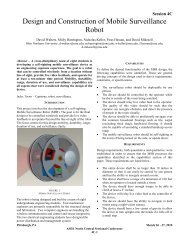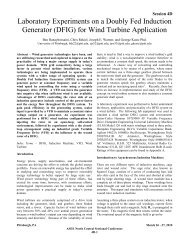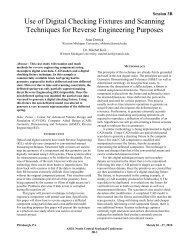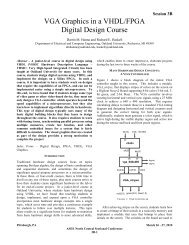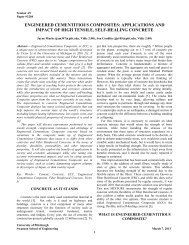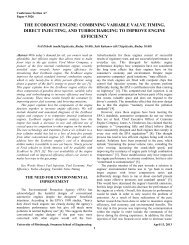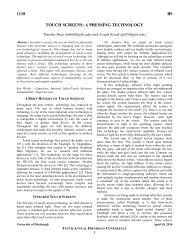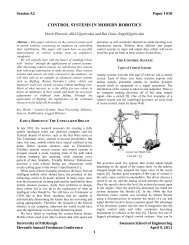ELECTROMAGNETIC & EDDY CURRENT BRAKING SYSTEMS
ELECTROMAGNETIC & EDDY CURRENT BRAKING SYSTEMS
ELECTROMAGNETIC & EDDY CURRENT BRAKING SYSTEMS
Create successful ePaper yourself
Turn your PDF publications into a flip-book with our unique Google optimized e-Paper software.
Andrew Sponsler<br />
Sean Kurtz<br />
Moving Electricity<br />
The entire basis of the circuitry and construction of<br />
electrically actuated braking systems is in the concept of<br />
electric current. The formal definition of current is:<br />
= (1) [4]<br />
where i is current, q is charge and t is time [4]. Current is the<br />
change in charge over a change in time. Many of the<br />
relevant applications of electricity, such as the discovery of<br />
electromagnetism and induction of charge, have their roots<br />
in experiments with current.<br />
The entire notion of the feasibility of eddy current<br />
braking systems is predicated on the laws of<br />
electrodynamics. ECB use currents and induced magnetism<br />
to attract a rotating surface, thus slowing down a moving<br />
system [3]. The system relies heavily on the use of eddy<br />
currents to retard any given system.<br />
A note regarding the formal definition of current: in the<br />
context of electromagnetism, it is especially important to<br />
distinguish the definition of current to be a change in the net<br />
charge through an area. For example, take a solitary rod of<br />
copper and imagine a cross-sectional slice anywhere along<br />
the rod perpendicular to the length. Many electrons pass<br />
through this planar intersection at any given moment.<br />
However, since the electrons are passing through the plane<br />
in both directions, there is no net change in charge in any<br />
direction. If the same copper rod were attached to a rod, the<br />
presence of an electric potential would then create a flow of<br />
electrons through the cross-section and the rod would be said<br />
to be experiencing a current.<br />
Eddy Currents<br />
When a non-conducting material passes through a<br />
magnetic field, reactionary currents stir up beneath the<br />
surface of the metal. These circulating currents, called eddy<br />
currents, apply themselves against the magnetic field<br />
creating a force that is contrary to the field [4]. This<br />
principle is a product of Faraday’s law of induction.<br />
In order to provide a clearer basis of understanding, a<br />
brief overview of induction should be given consideration.<br />
Similar to an electric field, a magnetic field can pass through<br />
or be contained within an object. Thus how much of the field<br />
is contained within an object must be defined. The quantity<br />
of the magnetic field enclosed by an object is called the<br />
magnetic flux. The magnetic flux through area A is given by<br />
this equation.<br />
Φ = ⋅ (2)[4]<br />
Once the amount of magnetic flux has been<br />
quantitatively analyzed the flux equation can be used to<br />
formally state the Faraday-Lenz law of induction for a closepacked<br />
coil of N turns,<br />
= − (3)[4]<br />
The clearest example of an eddy current being induced<br />
in a conducting metal may be demonstrated by dropping a<br />
magnet through a vertically oriented copper pipe. The<br />
relative motion of the magnetic field, created by the magnet,<br />
past the conducting metal, the copper pipe, will create eddy<br />
currents inside the copper pipe and will slow the fall of the<br />
magnet. The magnet will quickly reach terminal velocity and<br />
will fall at a constant rate much slower than free fall. The<br />
currents are stirred up beneath the surface of the metal<br />
passing through the magnetic field. The swirling currents<br />
point in every direction in actuality; however, since the<br />
metal is in motion through the electric field, the only force<br />
that is “felt” is the force opposite of the direction of motion<br />
[5]. This antagonist force is the basis for an eddy current<br />
brake system.<br />
Levin et al. performed a study on eddy currents using<br />
the example of a magnet falling through a copper pipe to<br />
create an accessible model demonstrating Faraday’s theory<br />
of electromagnetic induction [5].<br />
FIGURE 1<br />
Diagram of elements involved in Levin’s experiment [5]<br />
In the study, a cylindrical magnet was dropped through<br />
a copper pipe of a certain radius. The study took record of<br />
the time the magnet took to travel through the length of the<br />
pipe. When a second magnet of equal mass to the first was<br />
attached to the first, the time required to travel through the<br />
pipe increased. It is assumed that a magnetically and<br />
electrically neutral object dropped through the copper pipe<br />
will have the fastest descent of all of these objects. From<br />
their measurements, Levin was able to calculate velocity,<br />
using the length of the pipe and the time of travel in the<br />
equation:<br />
= / (4)[5]<br />
University of Pittsburgh<br />
Swanson School of Engineering April 13, 2013<br />
2




